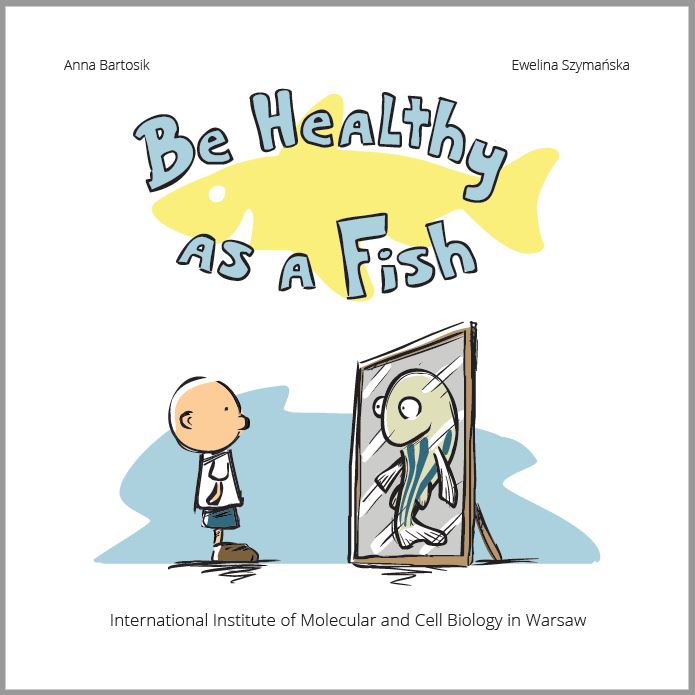Objective:
- Development of administrative staff competencies in providing services to and cooperating with people from abroad through specialized training, including language courses.
Number of places: 20
Implementation period: until September 30, 2027
Funding for participants: PLN 5,000 for language training for the duration of the Project
Review the following documents:

Cel:
- Rozwój kompetencji kadry administracyjnej w obsłudze i współpracy z osobami z zagranicy poprzez specjalistyczne szkolenia, w tym szkolenia językowe.
Liczba miejsc: 20
Okres realizacji: do 30 września 2027 r.
Finansowanie dla uczestnika: 5000 PLN na szkolenie językowe na czas trwania Projektu
Zapoznaj się z dokumentami:

The main character of the Be Healthy as a Fish educational campaign is the zebrafish, which helps scientists find the cause of certain human diseases and discover new-generation therapies and medicines. The program is directed towards children aged 9-12 years old.

Workshops
For the young target audience, the workshop is an opportunity to visit a real scientific institute. During the classes, the participants are introduced to the zebrafish as a model organism that is used in basic and applied research because of its high genetic similarity to humans, transparent embryos, very short reproduction cycle, access to experimental manipulations, a large collection of mutant/transgenic lines, and low maintenance cost. Therefore, the zebrafish is an attractive alternative to mammalian in vivo models and can be used to implement the “3R” principles (reduction, replacement, and refinement). To empathize with the role of scientists, the students observe 1- to 2-day-old zebrafish embryos under a stereoscopic microscope. They have the opportunity to see the beating heart of a small fish and living brine shrimp (Artemia) larvae and rotifers. They learn that zebrafish development is very similar to the embryogenesis of higher vertebrates. In contrast to mammals, zebrafish develop from fertilized, transparent eggs outside the mother’s body, which allows scientists to observe the embryogenesis process.
Participants of the workshop learn how much the human body is similar in its genesis and development to the body of a small fish. They learn that when scientists observe the zebrafish, human embryogenesis, and the mechanisms of the human body, various functions can be better understood. By explaining the concept of the homology of genomes, they are shown the importance of animals in the multi-stage process of discovering new drugs and therapies. We also show participants how we breed zebrafish and how we tend to their welfare. We familiarize children with the issues of ethics in research that is performed with animals. The participants independently investigate water properties by performing calorimetric tests and measuring the pH and hardness of tap water and aquarium water that is used in the facility. Water analyses are supervised by animal caretakers who work at IIMCB. The children are permitted to perform water tests themselves and have the opportunity to ask questions about zebrafish husbandry, fish biology, operation of the fish facility, and other tasks. At the end of the workshop, the students are given the Be Healthy as a Fish book and a three-dimensional bookmark with images of zebrafish.
Movie
The aim of the movie is to familiarize viewers with IIMCB’s facilities and scientific interests and show the everyday work lives of scientists. This 6-min movie is mostly animated. However, part of it shows real images of various locations within the institute (e.g., laboratories, fish facility, the office of the Director of IIMCB, and a lecture hall where the workshops are held). The storyline of the animation consists of a humorous tour around the institute that is guided by two cartoon characters: the Professor and a zebrafish. During the tour, the children are told the reason why the zebrafish facility was established, and they can witness the formation of a new international team of scientists. The viewers are informed that science has no borders, and new discoveries result from joint efforts of scientists around the world who exchange information during seminars and conferences. Both Polish and English versions of the movie are available on the IIMCB YouTube channel.
Book
The book brings the complex world of science closer to young readers. Because the book is geared toward primary school children with an elementary knowledge of life sciences, it is illustrated with cartoons to make the content more interesting for a young audience. Moreover, to help readers absorb the story’s message, the book provides engaging assignments. A short glossary defines terms that are used in the book that may be difficult for some readers to understand. Importantly, the factual content was created in consultation with an educational biology expert to ensure that the message of the story is both understandable and inspiring for a young audience.
The book is distributed to all of the participants of the workshop as an invitation to broaden their knowledge beyond the topics that are discussed in their classes. The content of the book was written such that it can be regarded as an independent story from which those who do not participate in the workshops can benefit. The Be Healthy as a Fish book can be interesting additional material for teachers to support discussions about the evolution of life, cell biology, heredity, and anatomical similarities between humans and animals.
Achievements
• Presentation about the campaign at 9th European Zebrafish Meeting in Oslo, Norway
• Poster prize at 6th European Forum for Marketing of Scientific and Research Organizations in Warsaw, Poland
• Publication in the Zebrafish Journal (Goś et al., 2016, doi: 10.1089/zeb.2015.1195)
• Presentation about the campaign at 7th European Forum for Marketing of Scientific and Research Organizations in Warsaw, Poland
• Publication in the Polish Journal of Environmental Sciences “Wszechświat” (no 10-12 2016)
"Be Healthy as a Fish" book
"Be Healthy as a Fish" movie
Publication in Zebrafish
Be Healthy as a Fish Educational Program at the International Institute of Molecular and Cell Biology in Warsaw, Poland
Goś Daria, Szymańska Ewelina, Białek-Wyrzykowska Urszula, Wiweger Małgorzata, and Kuźnicki Jacek. Zebrafish. June 2016, 13(4): 266-271. doi:10.1089/zeb.2015.1195.
The admissions process is conducted through the Doctoral School website system. The PhD student can apply to this specific project carried out as part of the Warsaw-4-PhD doctoral school via website https://shorturl.at/cJKQY (the application system will be activated from 25th of July, 2025; deadline for sending application is 8th August, 2025). For more information, please follow the link https://shorturl.at/mvxOR
- Reconstructing cardiovascular cell lineage evolution, one cell at a time NCN/OPUS (Laboratory of Zebrafish Developmental Genomics, 1 position)
- Dynamics of RNA-degrading complexes in bacteria NCN/SONATA BIS (Laboratory of Single-Molecule Biophysics, 1 position)
- RNA-Protein Interactions in Human Health and Disease NCN/DIOSUCRI (Laboratory of RNA-Protein Interactions - Dioscuri Centre, 1 position)
- Mechanistic and structural studies of adenoviral DNA replication NCN/OPUS (Laboratory of Protein Structure, 1 position)
The admissions process is conducted through the Doctoral School website system. The PhD student can apply to this specific project carried out as part of the Warsaw-4-PhD doctoral school via website https://shorturl.at/cJKQY (the application system will be activated from 19th December 2024; deadline for sending application is 6th January 2025). For more information, please follow the link https://shorturl.at/mvxOR
Projects available to apply:
- Degradacja RNA w ludzkim patogenie Acinetobacter baumannii. - 1 miejsce w Laboratorium Laboratorium Biofizyki Pojedynczych Cząsteczek
- Dynamika kompleksów degradujących RNA u bakterii. (NCN/SONATA) - 1 miejsce w Laboratorium Biofizyki Pojedynczych Cząsteczek
- Metabolizm terapeutycznych i endogennych mRNA. - 1 miejsce w Laboratorium Biologii RNA – Grupa ERA Chairs
- Badanie inicjacji translacji u pikornawirusów, jako potencjalnego celu terapeutycznego. - 1 miejsce w Laboratorium Wirusów RNA
- Wpływ czynników środowiskowych związanych z infekcją matki podczas ciąży na rozwój zaburzeń neuropsychiatrycznych u potomstwa ze stwardnieniem guzowatym w modelu danio pręgowanego. (NCN/SONATA BIS) - 1 miejsce w Laboratorium Neurobiologii Rozwoju(IMoL)
- Ewolucja kariotypów oraz obecność mutacji w ostrej białaczce szpikowej. - 1 miejsce w Laboratorium Biologii Strukturalnej
The admissions process is conducted through the Doctoral School website system. The PhD student can apply to this specific project carried out as part of the Warsaw-4-PhD doctoral school via website https://shorturl.at/cJKQY (the application system will be activated from 19th December 2024; deadline for sending application is 6th January 2025). For more information, please follow the link https://shorturl.at/mvxOR
Projects available to apply:
- Data-driven methodology for predicting, explaining and understanding of RNA and small molecule ligand binding. - PhD student in Laboratory of Bioinformatics and Protein Engineering
- RNA targeting and degradation in human pathogen, Acinetobacter baumannii. - PhD student in Laboratory of Single-Molecule Biophysics
- Dynamics of RNA-degrading complexes in bacteria. (NCN/SONATA) - PhD Student in Laboratory of Single-Molecule Biophysics
- Therapeutic and endogenous mRNAs metabolism. - PhD Student in Laboratory of RNA Biology – ERA Chairs Group
- Investigating picornavirus translation initiation as a potential therapeutic target. - PhD Student in Laboratory of RNA Viruses
- Influence of environmental factors related to maternal infection during pregnancy on the development of neuropsychiatric disorders in offspring with Tuberous Sclerosis Complex in the zebrafish model. (NCN/SONATA BIS) - PhD Student in Laboratory of Developmental Neurobiology(Zmorzyńska Group | IMoL)
- Design of “strealth” asparaginases for the treatment of acute lympoblastic leukemia (ALL). - PhD Student in Laboratory of Structural Biology
The admissions process is conducted through the Doctoral School website system. The PhD student can apply to this specific project carried out as part of the Warsaw-4-PhD doctoral school via website https://shorturl.at/cJKQY (the application system will be activated from 19th December 2024; deadline for sending application is 6th January 2025). For more information, please follow the link https://shorturl.at/mvxOR
Projects available to apply:
- Data-driven methodology for predicting, explaining and understanding of RNA and small molecule ligand binding. - PhD student in Laboratory of Bioinformatics and Protein Engineering
- RNA targeting and degradation in human pathogen, Acinetobacter baumannii. - PhD student in Laboratory of Single-Molecule Biophysics
- Dynamics of RNA-degrading complexes in bacteria. (NCN/SONATA) - PhD Student in Laboratory of Single-Molecule Biophysics
- Therapeutic and endogenous mRNAs metabolism. - PhD Student in Laboratory of RNA Biology – ERA Chairs Group
- Investigating picornavirus translation initiation as a potential therapeutic target. - PhD Student in Laboratory of RNA Viruses
- Influence of environmental factors related to maternal infection during pregnancy on the development of neuropsychiatric disorders in offspring with Tuberous Sclerosis Complex in the zebrafish model. (NCN/SONATA BIS) - PhD Student in Laboratory of Developmental Neurobiology(Zmorzyńska Group | IMoL)
- Design of “strealth” asparaginases for the treatment of acute lympoblastic leukemia (ALL). - PhD Student in Laboratory of Structural Biology




